Asus ROG Phone 3 review

64MP Quad-Bayer main camera and 13MP ultrawide
An amazing camera experience was never going to be high on the propriety list of a gaming smartphone. Even so, Asus has been consistently delivering perfectly adequate camera setups on the ROG Phone line. The ROG Phone 3 is no exception. Its main camera is, more or less, an incremental update over the one in the ROG Phone II. It uses the popular 64MP, Quad-Bayer Sony IMX686 sensor. It's a 1/1.7" unit, with 0.8 µm individual pixels and 2x1 OCL PDAF, sitting behind an f/1.8 lens. Nothing too glamorous or spectacular. There is no OIS, Laser AF and just a simple one-LED flash setup. Even so, the Sony IMX686 has proven its salt as a capable shooter.

Furthermore, in conjuncture with the Spectra 480 ISP, Asus has managed to squeeze out an impressive feature set out of the otherwise modest main camera. Especially in the video capture department, where the ROG Phone 3 has impressive EIS stabilization, all the way up to 8K resolution, as well as HDR video capture and even a full-featured Pro video capture mode.
Complementing the main 64MP camera, the ROG Phone 3 has a rather unremarkable 13MP ultrawide (OmniVision OV13855). It has a 125-degree field of view and a rather dim f/2.4 lens. Last and probably least - a 5MP, f/2.0 camera. As per our hardware-digging efforts, it actually uses an OmniVision OV8856 sensor, which has a native resolution of 8MP. It acts as a dedicated macro shooter, which is arguably, a bit better than simply having a depth sensor.
Around the front of the ROG Phone 3, we find another Quad-Bayer snapper. This one is a 24MP, OmniVision OV24B1Q, with an individual pixel size of 0.9 µm, behind am f/2.0 lens. No autofocus, or anything too fancy, but still plenty of potential, thanks to the 4-cell Bayer imaging setup.

The ROG camera app UI is a fairly custom affair. We would say it is surprisingly feature-rich without being chaotic. It does still have certain idiosyncrasies to it, though, that might need addressing. For instance, we only managed to enter 4K HDR video mode through an on-screen prompt that only shows up when you do into 8K video capture.
The options on the main camera UI are all self-explanatory. There is just a single beauty slider to the right, with no additional options. If you want more control over that, you have to switch over to the dedicated Portrait mode. Besides a slider for the intensity of the blur effect, it also features in-depth controls to thin cheeks, enhance eyes, brighten skin, soften skin and change its tone.






Portrait mode, complete with beauty filters
The same set of options for stills in both the default and Portrait mode are also carried over to the selfie camera UI.
The camera app does a fair bit of automatic scene detection. This is indicated by a small icon in the top left corner, as well as a Night Mode UI, which automatically pops-up in the bottom right corner, when the camera decides it is dark enough. You can toggle the automatic night mode off in the settings, if you want more control. Also, clicking on the Night mode icon itself presents two options for exposure duration. The numbers themselves are dynamic and also dependent on ambient light conditions. One denotes a shorter exposure, while the other - a longer one.



Automatic Night mode detection
If, for instance, the light is almost enough to pull off a good shot without night mode, but the ROG Phone 3 still automatically decides to turn it one, you usually get an exposure time of around 3 seconds. If you then enter the quick selection menu, the 3 second mode should be set as the "longer exposure" value, with the lower one simply turning Night Mode off.
Alternatively, if it's really dark, you might find that the lower exposure time is in the 5 to 8-second range, with the longer option potentially going all the way up to 25 seconds. This dynamically populated selector is definitely a custom Asus control and one that is surprisingly convenient.
On top of that, there is also a dedicated Night mode in the camera app, which always applies at least some minimal value to the shorter exposure option.
Pro mode is surprisingly versatile. You get a level meter in the middle of the frame, as well as a histogram in the bottom left corner. WB adjustment goes from 4500K to 7500K. Exposure compensation can be set between -2 and +2. ISO goes from 25 to 3200. You can do shutter speeds between 1/60 and 32 seconds and the is a manual focus slider.
There is a Pro video capture mode, as well. It offers the same set of controls on the right-hand side as Pro photo mode, as well as a nifty smooth zoom feature. You can just click on an area in the frame and then have the phone gradually zoom to it. The ROG camera app also allows smooth switching between the main and ultrawide cameras while filming.
Video options on the left side of the frame are the same for regular Video recording mode and Pro mode. Interesting among these is the stabilization toggle. It enabled and disables HyperSteady, which goes one step beyond the regular EIS video stabilization, controlled via a central toggle in the Video setting screen. HyperSteady is only limited to FullHD resolution and only works on the ultrawide camera. You can't use it together with the smooth zoom feature either.
The ROG phone 3 also has what it calls Audio effects. Once enabled via the settings menu, these are controlled from a small menu shortcut, denoted by a microphone icon, in the top right corner of the UI. You get two features - automatic mic zoom and wind suppression. Once enabled, each gets its own status icon in the top left corner of the UI. Both work surprisingly well. Or rather unsurprisingly so, considering the powerful four-microphone array on the ROG Phone 3.
There are plenty of settings to play around with in the camera app, both for stills and video capture. We have to admit, Pre-AF, in particular, still has us a bit confused as to its exact purpose and effects. The ROG Phone 3 lacks a dedicated camera shutter, let alone a dual-stage one, which could have made the option a bit more logical. Side note, we think Asus should consider including the option to set-up one of the excellent ultrasonic AirTriggers of the ROG Phone 3 as a shutter. Thanks to its pressure precision and haptic feedback, it can likely mimic a two-stage shutter key fairly competently.
We appreciate the addition of a h.264 and h.265 (HEVC) codec selection in the video capture settings. Among other options, we already mentioned in some detail.
Still image quality
In good lighting conditions, the 64MP main camera on the ROG Phone 3 produces perfectly decent stills, at a little below 16MP in resolution, after the Quad-Bayer algorithm does its job. Detail is plenty and we like the more-natural looks to the colors.






ROG Phone 3 main 16MP camera samples
Admittedly, noise is a bit too much for our taste and the dynamic range is narrow. Typically, we would reach for the HDR algorithm to get that sorted out, as best as possible. With modern computational photography, you can really go beyond what the hardware is natively capable of.
At least, we found no issues with the detection part of the algorithm. Auto mode sprang into action at just the right times.
You can capture photos at the full 64MP resolution of the Sony IMX686, though that hardly offers benefits in terms of detail and tends to introduce a bit more noise in the frame. This isn't how Quad-Bayer sensors are meant to be used, and you can also see chromatic aberrations and some wrong and algorithmically made-up lines and shapes, especially in fine patterns.






ROG Phone 3 64MP main camera samples
Speaking of algorithmic issues, even in its proper 16MP mode, the main camera on the ROG Phone tends to often represents some straight lines extra-thick in places. It's a weird bug, potentially related to image sharpening.
Portrait shots come out looking clean with nice subject detection and separation. Background blur also looks neat and convincing.


ROG Phone 3 portrait mode samples
Surprisingly, Portrait mode managed to perform nearly as well with non-human subjects.

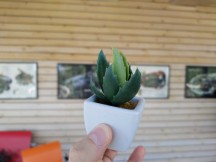

ROG Phone 3 portrait mode samples
Like we already mentioned, most beauty tweaks on the ROG Phone 3 camera are also housed within the Portrait mode. If you are not careful with the sliders, you can end-up with comedic results. When used in moderation, the effects do work well.



ROG Phone 3 portrait mode and beauty mode samples
Zooming is naturally available on the ROG Phone 3. You can go up to 8x, which is being done through the main 64MP camera. The ROG Phone 3 press materials do mention lossless 2x zoom, by using the Quad-Bayer camera in a "clever" manner and when there is enough light to pull it off. However, there is no easy toggle to do 2x in the camera UI that would suggest the lossless nature of the zoom. You just have to pinch and zoom to the right spot.






ROG Phone 3 zoom samples: 1x • 2x • 8x • 1x • 2x • 8x
Zoomed shots look decent-enough at 2x, though a bit too soft to be labeled "lossless" in our mind. 8x is clearly heavily-digitally enhanced. Many of the lines are painted-over and restored. Even so, there is still a surprising amount of usable detail.
Not unlike the main camera, the 13MP ultrawide on the ROG Phone 3 is perfectly decent, but very-much unimpressive. It has a general softness to it, that can be off-putting.






ROG Phone 3 ultrawide camera samples
Still, that's about what we would expect out of the OmniVision OV13855. Perhaps a bit of extra software sharpening can push along further.






ROG Phone 3 ultrawide HDR On camera samples
HDR Auto mode worked out just fine on the ultrawide, as well, kicking-in as needed. In most cases, the algorithm managed to do its job properly, with recovered details in otherwise crushed shadows being the most obvious benefit.






ROG Phone 3 ultrawide HDR Auto camera samples
There is no autofocus on the ultrawide camera, which means it can't pull double-duty for some fancy macro shots. The ROG Phone 3 has a dedicated 5MP macro camera to handle that. It is also fixed-focus and not particularly special in any way.









ROG Phone 3 macro camera samples
The resolved detail isn't that much and you do need to be particularly careful about the distance you are from the subject, but with enough patience, you can still get some surprisingly nice shots out of this small camera.
We do appreciate the fact that the camera app starts hinting that you should switch over to macro mode when you try to get too close to your subject in regular photo mode.
Low-light still image quality
Low-light performance on the ROG Phone 3 is a bit of a mixed-bag. As far as the main 64MP camera goes, we were mostly please with how in held-up. There is surprisingly little noise left behind in most shots, detail is about what you would expect from a modern Quad-Bayer sensor, which is to say perfectly adequate and the camera rarely got tripped-up by complex and conflicting light sources.
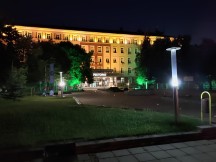



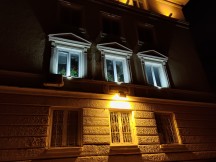
ROG Phone 3 low-light camera samples without Night mode
Asus has a rather interesting take of its own on Night mode implementation. We found that simply leaving the automatic detection on in the settings (which it is, by default), the camera generally does a fine job of determining just when to enable Night mode and with how long of an exposure, without having to ever leave the default photo mode.
If the phone detects a particularly dark scene, it doesn't shy away from bumping the exposure time even if you are not in the dedicated Night mode. And if tripod-detection kicks in, it will happily do a 25-second or even 32-second shot completely of its own accord.




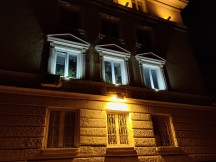
ROG Phone 3 low-light camera samples with Auto Night mode
Depending on the particular scene, Night mode can have effects ranging from almost unnoticeable to surprisingly effective, often managing to bring-back entire section of otherwise dark frame. We noticed that Night mode doesn't really do much for clipped areas, say near very bright light sources.
You can get a bit more hands-on with low-light shots to try and fix that, to some degree. For one, the ROG camera app supports separate exposure and focus lock points. You can long-press on a spot in the viewfinder to lock both at the given location, after which you can drag the AF point to a different location.
As we said, the dedicated Night mode, will still automatically estimate a shot and long exposure setting for you, but these tend to typically be a bit higher than the once the algorithm will settle on under the default photo mode.




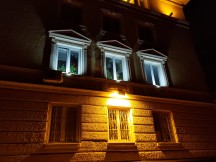
ROG Phone 3 low-light camera samples in Night mode on the maximum suggested exposure time
Beyond that, there is always Pro mode, which hands over control entirely.
Honestly, the main 64MP camera on the ROG Phone 3 can often get away without resorting to Night mode, at all. The ultrawide, however, has the disadvantage of dim f/2.4 lens.
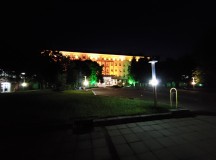




ROG Phone 3 ultrawide low-light samples without Night mode
Night mode for it is often the difference between a throw-away photo and one that is actually usable to some degree.
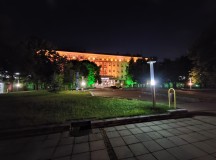



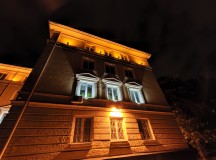
ROG Phone 3 ultrawide low-light camera samples with Auto Night mode
The algorithm knows that all too well and tends to suggest longer exposure periods for the ultrawide, regardless of which mode it is operating in.



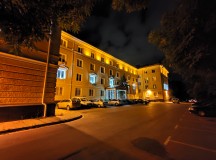

ROG Phone 3 ultrawide low-light camera samples in Night mode on the maximum suggested exposure time
Finally, we added the ROG Phone 3 to our extensive photo compare database, both in its intended 16MP resolution and at 64MP. Feel free to pixel-peep.



Asus ROG Phone 3 against the ZTE nubia Red Magic 5G and the Xiaomi Poco F2 Pro in our Photo compare tool



64MP: Asus ROG Phone 3 against the Motorola Edge and the Xiaomi Redmi K30 in our Photo compare tool
Selfie photo quality
We are just as happy to see a nifty Quad-Bayer sensor on the front of the ROG Phone 3. The 24MP, f/2.0 module produces 6MP shots and is not particularly fancy in terms of additional features. It is a fixed-focus unit, but focus distance is well set at just about an arm's length. Focus depth is perfectly sufficient too.






ROG Phone 3 selfie camera samples
Detail is good, so are colors and sharpness. The way the ROG Phone 3 handles bright lights in combination with thick shadows in the same frame is impressive.



ROG Phone 3 selfie camera samples
You can do Portrait mode shots on the selfie camera, as well. Without any additional camera for depth detection, the subject separation on this one is not nearly as impressive as on the main camera. Even so, results look surprisingly good. Small hairs and glasses still manage to trip the algorithm up, but the blur effect looks impressive overall.






Rog Phone 3 selfie portrait samples






Rog Phone 3 selfie portrait: Off • Medium • Max • Off • Medium • Max
The full beauty mode suite is also carried over to the selfie camera. Just like on the main camera, it's a very versatile mode filled to the brim with beautifying features. Most of these, however, can go to some extreme "Sims character creator" values, making it rather easy to go overboard with the effect. No real hard though, since there is some comedic value to be had from playing around.






ROG Phone 3 selfie beauty mode samples



ROG Phone 3 selfie beauty mode: Off • Medium • Max
A dimly-lit room is not particularly challenging for the ROG Phone 3's selfie camera. Quality remains high, and noise - surprisingly low. Even Portrait mode remains usable.
One it gets properly dark, the phone's selfie game takes a hit, especially if you torture the limited dynamic range with odd light sources. Even in these conditions, though, photos still remain usable. There is no Night mode for the selfie camera, automatic or manual.



ROG Phone 3 low-light selfie camera samples
We have to say that, overall, we are quite pleased with the selfie experience. Especially considering this is not a camera-centric phone, let alone a selfie-centric one. Though, a certain niche of mobile game-streamers might still appreciate the extra attention this particular camera has received.
Video capture quality
The ROG Phone 3 can go all the way up to 8K resolution, at 30fps on its main 64MP camera. Better still, even at this high resolution, the camera app still lefts you use the advanced audio features - Mic focus and Wind noise reduction. You are free to choose an encoder of your choice, as well - h.264 for the best possible quality or the dynamic h.265 (HEVC) to save some space at a small expense to quality.
Framerate isn't terribly stable at 8K, but there are only occasional drops - few and far between. Bitrate is very respectable at around 104 Mbps. Just like with all other video resolutions and modes, you get a standard AVC stream, plus a stereo 48 kHz AAL audio one.
Detail looks amazing at the full 8K resolution. We also enjoy the color rendering - not too oversaturated and not too plain. Dynamic range is a bit limited when compared to other 2020 flagships. However, that's a high bar to clear in the first place.
If your computer or player of choice lacks the horse-power or hardware decoder, necessary to handle 8K, you can drop down to 4K at up to 60fps. Processing remains consistent, and so does the impressive level of detail and overall quality. Even at FullHD, clips from the ROG Phone 3 remain competitive. Just the dynamic range issue persists across the board, resulting in it some clipped shadows and overexposed bright areas. Here is the full playlist of sample videos we captured from the main camera of the ROG Phone 3.
The ultrawide camera on the ROG Phone 3 does up to 4K@30fps. With a dimmer lens and less-impressive sensor, it suffers from even narrower dynamic range. On the plus side, Asus did the best it could to keep other aspects of the video consistent and competitive, like color rendition. The detail is decent for the sensor at hand. Here is a playlist of clips from the ultrawide camera.
Asus did an impressive job in the video stabilization department. The ROG Phone 3 may lack OIS on all of its cameras, but it still benefits from an excellent 3-axis EIS system. The most impressive part has to be the fact that EIS can be used at the full 8K resolution and with surprisingly good results.
Naturally, since the stabilization is electronic, you will be giving up a portion of the frame. But, we find the tradeoff perfectly reasonable. EIS arguably works even better on the ultrawide camera. Once again, it can go up to the maximum 4K resolution of the respective module.
Beyond the regular stabilization toggle in the settings menu, the ROG Phone 3 also has advanced stabilization, called HyperSteady. It can be turned on from the hand icon on the main video UI of the camera app. Once on, it limits the capture resolution to 1080p, which is necessary, since it crops quite a large section of the ultrawide sensor to do its job.
Results are impressive. HyperSteady managed to produce a perfectly-pleasant to watch, "floaty" video even during sprints with lots of tossing-about - all without destroying the overall quality of the clip too severely.
For the sake of thoroughness, here is the main camera with stabilization at 4K resolution.
The ROG Phone 3 can capture HDR video. The option is a little hard to find. The only way we managed to get to it was by going through 8K video capture first, outside on a sunny day, and then waiting for a pop-up to show, suggesting we try the mode. It is limited to 4K, which we can't really complain about.
Actual HDR video clips, however, are a mixed bag in terms of quality and especially consistency. Brighter scenes seem to trip-up the algorithm, often leading to sudden and abrupt flickers between what seems like different exposure settings in parts of the frame. The mode is pretty cool when it works, but it needs a bit of extra polish. We should remind you, that our review unit is still running beta software at the time of writing this text and is constantly receiving OTA packages. So, work is being done all-around.
Perhaps one of said updated will also address one of the other occasional issues we had with video capture on certain occasions, regardless of shooting mode - focus hunting. Or rather, short periods of slow reaction from the focus algorithm, leading to snippets of blurry footage. One the software does snap into action and grabs proper focus, it manages to typically hold on to it very well.
Low-light videos on the ROG Phone 3 are decent, but nothing to phone home about. The dynamic range issues become even more apparent in challenging lighting conditions and you can really see the noise-suppression algorithm working overtime in more uniform areas of the frame.

The ultrawide suffers particularly bad in these conditions, mostly due to its dim aperture. Low-light videos from it are too dark and borderline unusable. If you stick to the main camera, though, you can get some decent results. EIS remains just as excellent, regardless of lighting, and so do the advanced audio features. You can, once again, go up to a full 8K resolution. We have compiled a playlist of all of the low-light samples we took for your convenience.
Finally, the 24MP selfie camera on the ROG Phone 3 deserves some praise for its video capture qualities, as well. Like we already mentioned, Asus clearly put some extra effort into this snapper, likely to improve the streaming experience for its gaming audience.
EIS continues to shine on the selfie side, as well. It seems to crop a bit more of the frame to do its job here, necessitating a far-stretched hand position to get a face fully in frame. It's hardly ideal with a 240-gram phone.
On the flip side, we are impressed with the liberal focus depth the fixed-focus selfie snapper provides. Plus, you should probably grab a monopod of some sorts if you are serious about vlogging in the first place, which will spare your arms from getting numb.
Rounding-off the video quality section, we didn't forget to include samples from the main camera of the ROG Phone 3 in both 8K and 4K resolution in our video compare database.



Asus ROG Phone 3 against the ZTE nubia Red Magic 5G and the Oppo Find X2 Pro in our Video compare tool



8K: Asus ROG Phone 3 against the Samsung Galaxy S20 ultra and the Motorola Edge+ (6K) in our Video compare tool
Reader comments
- Mackie
- 18 Jan 2024
- P@c
I resolve the same issue by conducting CPU reball 44.8 USD repair cost
- Anonymous
- 14 Jul 2023
- P@c
WiFi suddenly don't work after the update. you can press the WiFi button on the settings but if you go back home and return to the settings its now turn off. It will stay no WiFi for a week, then after that when you reset the phone the WiFi...
- G4
- 06 Jul 2023
- fsV
Same here, mine is still running android 10. I downloaded the uodate manually but it's refusing to update. It shows me update failed. Apart from that i have no issues with the phone, everything still works perfectly.




































